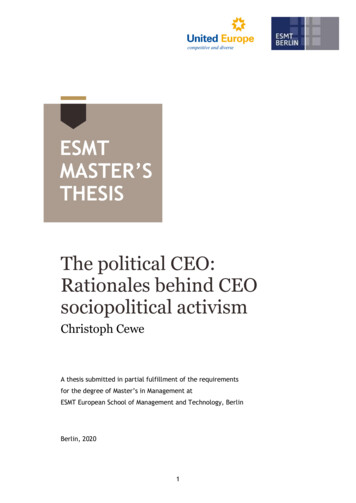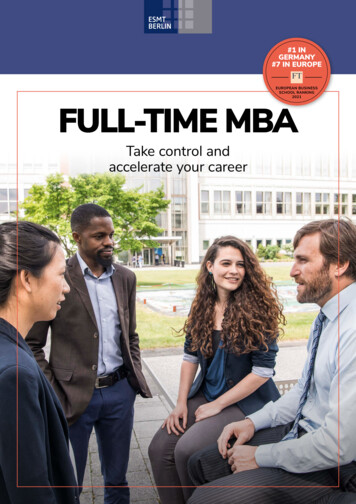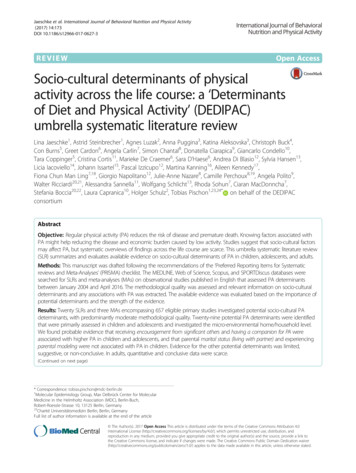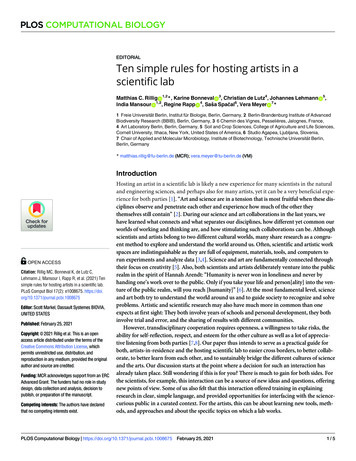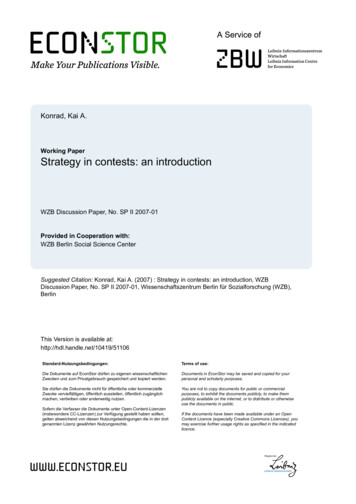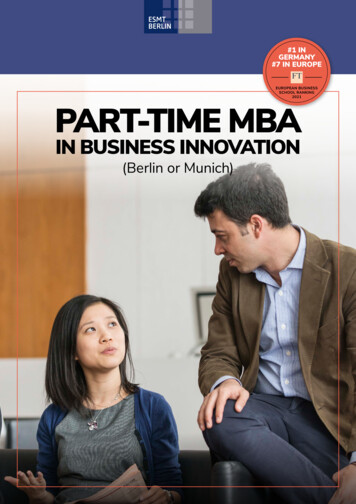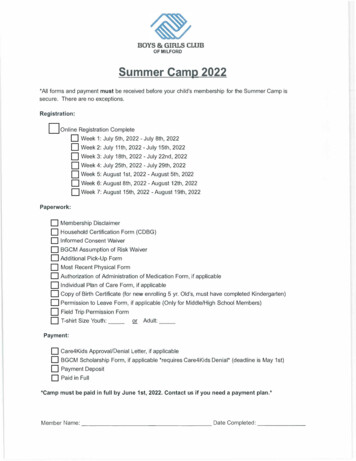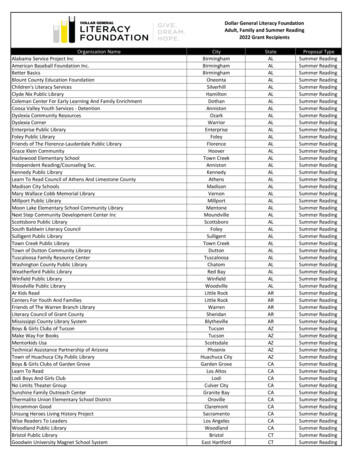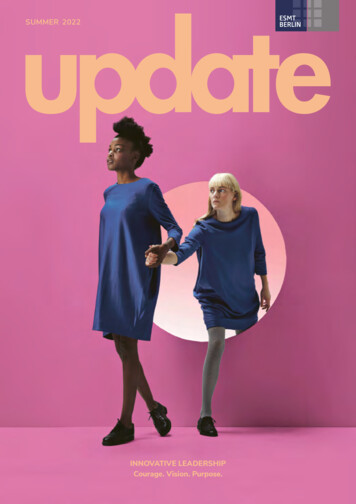
Transcription
SUMMER 2022INNOVATIVE LEADERSHIPCourage. Vision. Purpose.
MBAPROGRAMSTAILORED TOMEET YOURNEEDSFULL-TIME MBA15 monthsEXECUTIVE MBA18 monthsFace-to-faceStrategic leadershipManagerial analyticsInnovation and entrepreneurshipFace-to-face10 modulesLeadership development &InnovationPART-TIME MBA24 monthsGLOBAL ONLINE MBAUp to 5 years75% online – 25% face-to-faceBerlin or MunichBusiness innovation#1 INGERMANY90% self-paced – 10% liveFlexible study timeTechnology & innovationEARLY ADMISSION DISCOUNTAND DIFFERENT SCHOLARSHIPSAVAILABLEEUROPEAN BUSINESSSCHOOL RANKING2021degrees.esmt.berlin/mbaprograms
EditorialThe topic of this issue of ESMT Update isinnovative leadership, but neither innovation nor leadership exist in a vacuum. Wemust acknowledge what is happening in the world, beyond the walls of our businessschool. Back in the spring of 2020, the World Health Organization officially declared thatCOVID-19 had become a pandemic. What followed was for many unprecedented; therecame a call to global cooperation in the face of a novel and fast-evolving threat to us all.Two years later, while the world still struggles with the enormous toll of the coronaviruscrisis, another crisis has erupted. Brutally, cruelly, and despite global condemnation, Russia wages war on Ukraine.Whether coincidence or cosmic irony, I am thinking andwriting about these crises here in the former State Council building that was once the home of the East Germangovernment. ESMT Berlin, founded by 25 global companies, is located in the very place where free markets andthe free exchange of ideas were impossible. We are justa few kilometers away from where the Berlin Wall stood,and, not too many decades or kilometers from that, wherehorrific human atrocities were masterminded.But it is precisely the histories of this house, this city,and this nation that show that it is worthwhile to standup for liberal values and to loudly insist on the value ofhuman life, liberty, and justice. The recent events havehistorical breadth, and they demonstrate the great needfor responsible and innovative leadership.Tomorrow’s challenges are considerable. And at thisvery moment its potential is being undercut in immeasurable ways. The world of today was made better by theinnovators of yesterday – great thinkers and planners – inwhose paths we all walk. Together, we can take stepsboth large and small to secure our common, sustainable,and peaceful future.As I wrote to the ESMT community at large just afterRussia invaded Ukraine, this war could not stand in stricter contrast to what we stand for. Bound by our commonpurpose of empowering people to create a better tomorrow, we bring together faculty, staff, students, and manyother stakeholders from all over the world who shareour strong beliefs in freedom, respect, and responsibility.Our direct reaction to Russian aggression was to immediately distance ourselves from the Russian state as well asstate-owned companies and institutions and to freeze allexisting relationships with them. This included cancelingall educational programs planned in Russia. ESMT students, alumni, and colleagues from Russia remain a highlyvalued part of our community. They are not responsible forthis war and the actions of the Russian government.From the beginning, we have worked together withour Ukrainian students and alumni to find the best waysin which ESMT, as an institution and a community, canprovide support. This has included a successful donation drive to send food and medical supplies directly toUkraine, as well as private donations and a benefit concert that raised funds for Feine Ukraine, an NGO workingon the ground to provide humanitarian aid to those mostcritically affected by the war. Additionally, alumni andstudents have initiated a project to provide career services for Ukrainian refugees in Germany, and Russian andUkrainian students are volunteering to teach German toUkrainians now living in Berlin.Many within the ESMT community are supportingincoming refugees – directly upon their arrival at Berlin’scentral train station or by opening their homes. This listis in no way comprehensive, but it should serve as areminder that, individually and as a community, we canlead the way to a better tomorrow.In closing, I would like to thank you all for your continued interest and support. I invite you to turn the pageand discover more about innovative leadership and thelatest events at ESMT.JÖRG ROCHOLLPresident, ESMT Berlin3
IN THIS ISSUESUMMER 2022ON THE PODCAST13Fintech is a feminist issuewith Solape Akinpelu23We’re not doing CSR anymorewith Alyssa Jade McDonaldBärtl03EDITORIALGetting to noby Martin Schweinsberg09Aurora Lecture on women,peace, and securityESMT Berlin hosts GlobalSolutions Summit 2022INSIDE ESMT28IN THE NEWSOf Note19Sustainability is personnelby Matthew S. BothnerThe pandemic didn’t kill offDEI. What’s next?by Bianca Schmitz and Nan Guo1525Remote leadership,tailored to fitby Nora Grasselli1824FEATURES05IN PICTURESEntrepreneurs perform betterif able to choose their ideas ORteam members – but not bothby Linus Dahlander29Reading Room31In Profile with Isabel vonWesterholt34Alumni at LargeImprintEditorial: Tammi L. Coles, Senior Editor,tammi.coles@esmt.orgContributors: Molly Ihlbrock, Director of CorporateCommunications; Jeanne M. Gaebler, Deputy Directorof Corporate Communications; Jennifer Reo, PressSpokespersonCreative Design: Eva GonçalvesPrinting: Köllen Druck Verlag GmbHPhotography: Cover photo via Getty Images. Otherimages used under license from Depositphotos.com,Shutterstock.com, and by permission of ESMT faculty,staff, alumni, students, and guests.Postmaster: Send changes and corrections to ESMTBerlin, Corporate Communications, Schlossplatz 1,10178 Berlin, Germany; newsletter@esmt.org.Copyright: 2022 by ESMT Berlin. Published biannually.Printed in Germany.
Getting to noby MARTIN SCHWEINSBERGFEATURECOVID-19 has changed how wework with people partially workingfrom home and in geographicallydispersed teams. Leaders mustnow communicate across differentcultures and channels, requiringempathy and precision.5
Leadership in this new world is just as much about sayingyes as it is about saying no. As a leader, you say yes toempower your people and their most valuable projects.However, leadership is also about saying no, so yourpeople can focus on what matters most.Saying yes is simple: your yes both affirms your relationship with a team member and their idea. Saying no isdifficult, causing many leaders to sugarcoat and weakentheir no. However, a weak no leaves you and your peoplewith nothing, as your people feel both personally rejectedand confused about what to do next.Saying no is difficult because we don’t want otherpeople to feel bad. As a leader, you might say no specifically to an idea that a team member proposed, butwhat your team member hears is that you are saying noto them personally.As a leader, you probably underestimate both howoften your people feel rejected by you and how muchthat affects them. Consider these findings from severalpsychological studies: Study participants play simpleball-tossing games in groups of three. Two of theseplayers are in reality confederates of the experimenter,the third player is the actual study participant. After allthree players throw the ball back and forth a few times,the two confederate players throw the ball back and forthonly between each other, but do not longer throw the ballto the third player and actual study participant (Williams,1997). What sounds like a simple child’s game was a veryunpleasant experience for the participant who didn’t getthe ball anymore: their self-esteem suffered as they feltrejected, and they became angry and sad.Next, researchers specifically changed the game tosee whether these changes would help participants notfeel bad when they don’t receive the ball anymore: participants now played a virtual computer game (Williamset al., 2000) in which two of the three players againstopped throwing a ball to them. The game is virtual,only lasts a few minutes, the participant doesn’t knowthe other two players and will never meet them, andthe game has no consequences. Do people care whenanonymous others stop throwing a virtual ball to themfor a few minutes?People do care. Naomi Eisenberger and colleagues(Eisenberger et al., 2003) had participants play this gamewhilst being in an fMRI scanner, and they found thatsocial and physical pain overlap in their neural pathwaysand processes: social pain is experienced the same wayas physical pain.Psychologists struggled to make this effect go away,even when they created weaker and weaker versions ofthe game: Eisenberger et al. (2003) told participants inanother study that they could not actually join in the gamebut only observe it because of a computer error, and theystill reported similar results. In another study, participantsIf even very weak social signalsin construed games lowerpeople’s self-esteem, how muchbigger is the impact of potentialrejection by their leaders?6ESMT UpdateSummer 2022
were informed that the two other players were not realpeople, that they were played by a computer, and that thecomputer had been programmed to stop throwing theball to them at some point. Even these participants hadlower levels of self-esteem simply because the pre-programmed computer players had stopped throwing thevirtual ball to them for a few minutes (Zadro et al., 2004).If even very weak social signals in these construed gameslower people’s self-esteem, how much bigger is the impact of potential rejection by their leaders?Furthermore, many face-to-face office conversationshave been replaced with text-based communication viaemail or chat. Text is very efficient, as it can reach manypeople whenever and wherever it’s convenient for them.However, text-based communication is also dangerouslyambiguous when the topic is emotionally charged (forexample, when you say no to a team member's idea). Ina face-to-face conversation, your team member can hearthe warmth in your voice, they see your smile and themany other signals you send to tell them they are worthy.Your people do not get any of that when they only readFEATUREyour email. Your emails sound warm and friendly to you,but your team members hear what their rejection-sensitive brains tell them to hear.How can you say no?So, what can you do? How can you learn to say no better?One simple thing you can do is to adapt a powerful negotiation principle into your leadership style. Negotiatorslearn that they have to be tough on the issues but friendlyto the person, if they want to stay in business and buildsustainable relationships.Three steps to saying no effectively:Say no specifically and unambiguously to the ideathat you want to decline. Make sure you’re saying noto the person’s idea, not to the person who proposedit. For example, you can write, “No, unfortunately wecannot launch another product line, given the currentmarket conditions.”7
As a leader, it is your job to sayboth yes and no to focus yourpeople and your organizationon what matters most.Affirm your relationship with that person and confirmthat they continue to matter to you. You just said no tothe idea, now you have to assure them that you continueto say yes to them as a person. For example, you couldwrite, “Thanks for suggesting this, though. I really appreciate your innovative ideas and I’m looking forward tohearing how we can create more value as a team. Pleasestay in touch and let me know if you have any new ideasor suggestions.”Finally, and critically, you might think that you’re donenow, but you’re wrong: some of your people might stillfeel unsure and rejected. In a face-to-face conversation,you can read their facial cues, you can see the disappointment, and you can quickly affirm your relationshipwith them. However, you do not know how they actuallyfeel after you send off your email. You, therefore, have toproactively invite them to let you know if anything is stillunclear or if there is anything else they want to share.For example, you could close by writing something like:“Thanks again for suggesting this. Please do let me knowif there’s anything else we could talk about or if you haveany other suggestions or questions about this. I’d love tohear from you, and I’m looking forward to working withyou more on this.”As a leader, it is your job to say both yes and no to focus your people and your organization on what mattersmost. In the words of Steve Jobs, “focus ( ) means sayingno to the hundred other good ideas that there are.” Yourability to say no with precision and empathy is one ofthe most critical skills you can develop, because it is oneof the most frequent, high-impact activities of your day.Use these three steps to strengthen the relationshipswith your people and to help your organization focuson what matters most, whether you say yes or no to thenext idea.8ReferencesEisenberger, N. I., Lieberman, M. D., & Williams, K. D. (2003). Does rejection hurt? An fMRI study of social exclusion. Science, 302(5643),290–292.Williams, K. D. (1997). Social ostracism. In R. Kowalski (Ed.), Aversiveinterpersonal behaviors (pp. 133–170). Plenum.Williams, K. D., Cheung, C. K., & Choi, W. (2000). Cyberostracism:Effects of being ignored over the Internet. Journal of Personalityand Social Psychology, 79(5), 748–762. doi.org/10.1037//00223514.79.5.748Zadro, L., Williams, K. D., & Richardson, R. (2004). How low can yougo? Ostracism by a computer is sufficient to lower self-reportedlevels of belonging, control, self-esteem, and meaningful existence.Journal of Experimental Social Psychology, 40(4), 560-567.doi.org/10.1016/j.jesp.2003.11.006MARTIN SCHWEINSBERGAssistant Professor of OrganizationalBehavior, ESMT BerlinESMT UpdateSummer 2022
Sustainability ispersonnelby MATTHEW S. BOTHNERWhat kind of leadership will beneeded, according to your research?Leadership that deals well withambiguity in virtual settings – especially ambiguity in informal authorityor status – will be persistently in demand. The pandemic (and the virtualcommunication that has arisen withFEATUREIn an interview with Mercedes-Benz Consulting, Prof.Matt Bothner speaks on research and initiatives gearedtoward bringing sustainability into HR management.it) has reshuffled status orderings inworkplaces. A simple but far-reaching sociological observation thatgoes back to the late sociologist Roger V. Gould is relevant here: Two people who are similar in status are especially prone to conflict – sometimesdangerous conflict, as my co-authorsand I found in a study of collisions inFormula One (F1) racing. Without ahierarchy to normalize the interactions of these two people, competition (for influence, for instance) canescalate quickly into conflict.How does F1 racing relate to leadership in virtual spaces? I see three9
connections:First, a transition to virtual meetings may lead one colleague, whohad been doing well face-to-face, tonow do much less well online, whileanother colleague who wasn’t so effective in face-to-face meetings nowdoes significantly better online. So,the recent shock ends up equatingtwo individuals in status who werepreviously differentiated. Conflictisn’t too far away.Second, a shift to virtual leadership may bring together two individuals who were dominant in theirpreviously separate environments,but who are now thrust togetheras near-equals (e.g., managementmay decide it’s a great idea to scaleup the size of teams, because travelcosts are now at zero), so an effort toget new synergies actually producesnegative synergies.Third, among those who are alreadyclose in status, the threat of a continuing pandemic (soaking up time,energy, and resources) may throwgasoline on a simmering fire betweentwo near-peers in status, catalyzinglocal hostilities that were previouslylatent. Energy levels are drawn down,patience is thinned, and, again, conflictis even more likely to ensue.Each of these possibilities – independently or in combination – callsfor more reflection on how we leadothers and ourselves. We need moreself- and situational awareness tokeep from misinterpreting and overreacting to the noisy signals emittedin strained online interactions. Somethoughts on this, which my collaborators and I developed out of the F1study before the pandemic, are evenmore relevant now.One vital skill – and partof the solution to theforegoing issues – is thecapacity to give and receivehelp. Actually, this is morethan a skill; it’s an attitude.What skills do managers now need?How will this shape personnel development?One vital skill – and part of thesolution to the foregoing issues – is10ESMT UpdateSummer 2022
the capacity to give and receive help.Actually, this is more than a skill; it’san attitude and a set of learnablebehaviors – which have becomevitally important amid the pandemic. A protracted run of remote workhas clearly taken its toll on peopleand organizations. In response tothis, my ESMT colleague Prof. Gianluca Carnabuci has developed asocial-science-based approach torestoring human connection, trust,and engagement in virtual work. I’mvery enthusiastic about this and keenon seeing how far it will go.What’s self-evident is that a newapproach to giving and receiving helpis necessary. In the past, we supported our colleagues spontaneously,around the water cooler or espressomachine. Stripped of these opportunities, many have sought to replicatethe experience online, around ritualslike “virtual coffees.” These are oftenunsatisfying substitutes. Essentialin an online environment, as Carnabuci has shown, is an approach thatmakes it easy – and authentic – to offer mutual support that’s structured,time-bound, and energizing. He hasengaged managers and executivesin intense and focused bursts of helpexchange through a format known asthe Help Workout Exercise. And he’salso taught leaders how to ask forhelp, how to determine which helprequests are productivity-enhancingand which are not, and how to eludethe dangers of over-helping. There’sperhaps nothing more draining thana social butterfly who zealously triesto help in an unfocused way. So, Ibelieve skill in giving and receivinghelp also entails a strong dose ofself-discipline.How should HR departments integrate sustainability into their work?We typically think of sustainabilityat the macro levels of the societyor of the firm. Young people areFEATUREleading protests for climate justice.Regulators are busy setting newsustainability reporting frameworksand policies. But there’s also a clearneed to bring sustainability to themicro level, to the individual. MyESMT colleague Prof. Eric Quintanehas fascinating research pinpointingwhen workers experience their workas unsustainable. Quintane (in jointwork with Claudia Estévez-Mujica atthe University of the Andes in Colombia) developed an inventive researchdesign which showed that burnout– captured by the two dimensions ofexhaustion and disengagement – istraceable to measurable patterns inemail networks.Two findings strike me as mostsalient: First, the more employees areintertwined in reciprocal exchangeswith their superiors via email, thehigher their risk of burnout. Lots ofback-and-forth via electronic exchange with bosses is an early admonition, and one that’s relativelyeasy for attentive (but not intrusive)HR colleagues to detect. Reciprocalexchanges may go hand in hand –not just with employees getting absorbed by their bosses, but also withan absence of the more energizingface-to-face encounters that seemto me more congenial to workplaceflourishing. Second, and quite surprisingly, Quintane’s models revealthat sending emails after hours isassociated with a lower probabilityof burnout. One implication of thisresult is that a precipitous drop inafter-hours communication portendsimminent disengagement and/orexhaustion. (Needless to add, sucha pattern shouldn’t be met with an11
exploitative expectation to continueto work after hours!)What I find especially excitingabout Quintane’s research is that,without venturing into the contentof email exchanges, HR leaders candiscern and move on early warningsigns of unsustainable work patterns. One of the most promisingfuture steps for business schools andHR departments is to join forces incollecting, analyzing, and acting onpersonnel data valuable for makingindividual careers more sustainable.What are ESMT’s goals in the areasof sustainable leadership and sustainable people management?At ESMT, we have recently announced ASPIRE, a new strategyby which we will become one of theleading business schools in sustainability. Our aim is to strengthen ourfaculty in sustainability topics anddevelop our sustainability initiatives.These include the Sustainable Business Roundtable, a peer-to-peerlearning network of internationalcompanies, and the Climate Governance Initiative Germany, a network we co-started with the GermanCouncil for Sustainable Development (RNE) and Board Academy e.V.,which works to mobilize non-executive directors and supervisory boardmembers on business models thatembrace ambitious climate policy.We also wish to advance campusinitiatives, such as sustainability ambassadors, carbon accounting, andthe Net Impact Club.Aligned with these endeavors, weare working on the topics of sustainable leadership in close cooperationwith companies. For instance, we’vehosted one of our Sustainable Busi-Business schools andHR departmentscan join forces incollecting, analyzing,and acting onpersonnel datato make careerssustainable.12ness Roundtables on implementingsustainability in HR. Human resourcepractitioners exchanged best practices and challenges with sustainabilitymanagers from leading internationalcompanies. This is because we seeour role not only as conducting research and offering research-drivenrecommendations that can be applied in practice, but also as fosteringcollaboration and exercising thoughtleadership in sustainability. We inviteany interested companies to join theSustainable Business Roundtablenetwork to prepare for the next sustainability challenges.This article was adapted from an interviewthat first appeared in the 2022 whitepaper “Sustainable HR” by Mercedes-BenzConsulting GmbH, ng.de. Usedwith permission.MATTHEW S. BOTHNERProfessor of Strategy, ESMT BerlinDeutsche Telekom Chair in Leadershipand HR DevelopmentDirector of the Center for SustainableBusiness and Leadership (CSBL),ESMT BerlinESMT UpdateSummer 2022
ON THE PODCASTFintech is afeminist issueAfter working in marketing for several financial servicecompanies, I realized that there was low adoption bywomen of financial services. And I was wonderingwhy. While I was looking at the data, I could see thereality. These women could not make sound financialdecisions. I also noticed that the problem was veryacute for women living in rural areas, working on thefarms. A lot of women were enduring emotional andfinancial abuse from their partners. And some of thesewomen did not know that they could do better withtheir labour, with their human resources, or with theirfinancial resources.I saw waste in local economies. I saw waste at theglobal level. Africa loses about 60 percent of its annualGDP due to the economic gender gap. The digital divide in Africa is increasing, especially in the rural areas.Globally, 3.7 billion people do not have access to theinternet; half of them are women.SOLAPE AKINPELUCo-founder and CEO, HerVest,speaking with Campus 10178,in December 2021Listen now!We must look at financial inclusion for women througha gender-lens approach. It creates better dynamics.And these women who are empowered empowertheir communities; they empower their householdsby extension.If you want to lift up humanity, lift up women.ON THE PODCAST13
COMING IN SEPTEMBER 2023WHAT’SYOURPATH?RedesignedMASTER IN GLOBALMANAGEMENTLeading in the world of tomorrowNewMASTER IN INNOVATION ANDENTREPRENEURSHIPStart & disrupt business for goodNewMASTER IN ANALYTICS ANDARTIFICIAL INTELLIGENCEDevelop and apply data-drivensolutions to future challenges#1 INGERMANYEUROPEAN BUSINESSSCHOOL RANKING2021degrees.esmt.berlin/master-programs
Remoteleadership,tailored tofitJohanna was staring at her own facein the videoconference screen. Shewas alone – alone in her home office and alone in the virtual meetingspace. The meeting she led ended acouple of minutes ago; all her teammembers exited at the top of thehour for their subsequent calls. Eventhough they were not done. Not doneat all, muttered Johanna, annoyed.She desperately needed a solutionfor a problem that multiple clientshad flagged about their latest product. She knew her team had the skills,ability, and knowledge to tackle theissue and improve the product. Butnothing came from them today. Notone promising idea.The usual process of their daily standups and biweekly contentToday’s virtualteams andtheir remoteleaders needapproaches thatare a proper fitto the task athand.by NORA GRASSELLIupdates had been working reallywell. Johanna opened the meetingswith updates from the managementperspective, and then each memberhad an allocated timeslot of fiveminutes for the standup (with nofollow-up questions), 10 minutes forthe content update, and 10 minutesfor a Q&A. To keep them on their toes(and to make it more fun), Johanna
randomly pulled their names froman old bowl – there was no set order.As she pulled each team member’sname today, she literally saw peopleshrink from the screen. She had todiscard all the ideas they put forward. Frustrating. Two years into theglobal pandemic that forced much ofthe workforce to work from home,Johanna was disappointed. We stilldo not know how to collaborate virtually, she thought.Yuval Harari, historian and best- selling author of the books Sapiensand Homo Deus, asserts that whatdefines the human animal – oneof the most important differentiating factors – is large-scale, flexiblecollaboration. Unlike collaborativespecies, such as ants, who have theircollaboration mode coded in theirgenes, humans constantly invent andimplement new collaboration modes,writes Harari. Yeah, no surprise there.Since the global COVID pandemic hitin March 2020, our teams, organizations, and societies have developedand successfully implemented countless new ways of working together– while being apart.To address the topics of remoteleadership and virtual collaboration,we have been working with ourstudents and participants using ourgamified simulation entitled The Virus. (No kidding. If you want to learnmore about The Virus, check out theESMT Update 2020 Winter editionor my article with Bethan Williams:Under Cyberattack: Learning ForLeaders Through Play).For this simulation, groups of six to12 students need to work together ina remote or hybrid setup to resolve aset of tasks under time pressure. Thechallenge: each task is of a differenttype and requires a distinct collaboration mode and remote leadership. Ifteams and leaders assume that theycan simply use the same collaboration mode for the second task as they16did for the first, they will fail. Like Johanna failed in the story above. Shetried to apply a collaboration modeto an information-sharing task thatrequired creativity.Throughout The Virus, the teamsencounter five different task undary breakingDuring the first task – the “logical” one – participants must resolvea mathematical problem. Becauseeach player has a different part of theequation, the best way to collaborateis to share information. The one taking a leadership role collects the dataand puts together the solution. Thiscentralized leadership approach isthe most efficient way to resolve thissimple, linear, and well-structuredtask. Using chat or screen sharingfeatures for sharing numbers andfigures helps too.Most groups don’t find the “logical”task difficult, but many fail colossallyat the subsequent “creative” task.Here, the solution can be found if aspecific folding technique is appliedto the task sheets, a little like origami.Often, the “logical” task leader triesto apply the same mode: collect allinformation. There are two problemswith this approach. First, the information for this “creative” task is morecomplex and ambiguous, less easy toshare. Second, even if all informationis available, the task is not solved. Itneeds innovation. Teams that solvethe “creative” task use distributedleadership: it allows for trial and error, building on team members’ ideas.Just like in real life, the innovativeidea is likeliest from individuals whoare at the boundary of the team: fromless extroverted participants, fromwomen in a male-dominated organization, or from new hires.Looking at these first two tasktypes, we already see what Johanna could have done differently. Thestandups and info-sharing teammeetings need to deliver on a different task type than the ideationsession she tried to run. Using thecentralized, strictly structured approach thus didn’t bring the creativeideas she was looking for.But task types are not dichotomous. The third task in The Virus ischaracterized by “sharing.” Here, theteam is divided to three subteams.Our teams, organizations,and societies havesuccessfully implementedcountless new ways ofworking together.ESMT UpdateSummer 2022
Each needs to find a solution foranother and to get their own solution from the third. The role of theremote leader is to coordinate thework between the subteams. In onesplendid example of those we observed, a participant laid back in hischair, crossed his arms – signalingthat he was not otherwise workingon the task at hand – and focused thesubteams on exchanging solutions.For the “autonomous” task, eachteam member has a complex butstructured exercise to complete. Dueto their length and complexity, sharing the details of the individual tasksis counterproductive. Teams thatexcel with this task type often workin total silence, only breaking it to askfor support when nee
GLOBAL ONLINE MBA Up to 5 years 90% self-paced - 10% live Flexible study time Technology & innovation EARL ADMISSION DISCOUNT AND DIFFERENT SCHOLARSHIPS . by MARTIN SCHWEINSBERG . 6 ESMT Update Summer 2022 Leadership in this new world is just as much about saying yes as it is about saying no. As a leader, .
